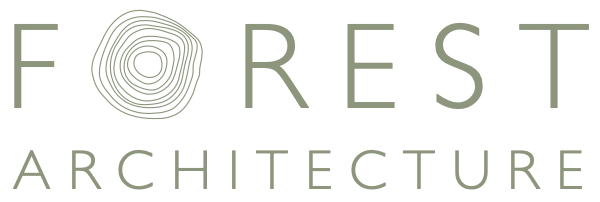
Located on the edge of the New Forest, Forest Architecture is an award winning architectural practice with a passion for integrating contemporary architecture into sensitive settings; in three National Parks.
We create well-crafted, beautiful architecture using natural materials and traditional building techniques. Intrinsic to each project is a narrative driven by a need to create a seamless relationship between our buildings and their context.
Our team
Natalie Skeete
-
BA(Hons) M.Arch MSc Building Conservation RIBA (Dist).
Natalie was born and brought up in London and originally considered becoming a dancer. However, she went on to study architecture and after completing her final qualification in 2012, she founded Forest Architecture later that year.
A former Masters student at the University of Bath, Natalie spent a number of years back at the university working as a Visiting Teaching Fellow and has since critiqued students at a number of other architecture schools.
Natalie’s love of old buildings led her to study the RIBA’s conservation course and she subsequently went on to complete a Masters in Building Conservation at the Weald and Downland Living Museum in 2021. Her dissertation on Hurst Castle, questioned the future of historic coastal buildings in anticipation of rising sea levels and increased coastal erosion and she continues to have a keen interest in whether such buildings should continue to be preserved or left to their inevitable loss.
Natalie has recently been appointed as the Buildings and Fabrics Team lead on a local Grade I listed church, advising on repairs an upcoming works.
She is a keen cook, she enjoys growing her own fruit and veg and she loves a forest walk.
Anna Burton
-
BArch (Hons) Dip. Arch
Anna has been drawn back to the coast, and now lives across the water from her home island of Guernsey. Moving to the mainland for university, she studied her initial degree in Nottingham and then later moved to London and completed her studies at Westminster University. It was whilst working in London that she gained experience on a range of projects; from a large scale mixed used development to one-off V&A exhibition. It was also in London that she had two formative experiences: gaining experience in high-end residential projects and meeting Natalie whilst working at the same Architectural practice.
After qualifying her and her new husband set off on an adventure to see the world. They returned nine months later and unpacked their backpack in Bath. Here her residential portfolio grew as she worked on a number of private homes including some listed buildings, a contrast in style to the one-off contemporary homes she went on to work on next.
Anna joined Forest Architecture in 2020 and enjoys working alongside Natalie, focusing on small-scale individual projects and often finds the simplest approach is best; a logical layout, clean details and a small palette of materials. She enjoys the challenge of designing something which not only meets the client’s brief but exceeds their expectations.
She can still be found exploring with her husband but now it’s in the New Forest, with two small kids in tow.
Portraits by Carrie Bugg Photography

Our philosophy
Forest Architecture is committed to creating beautiful, well-crafted buildings in sensitive contexts
The work Forest Architecture produce encompasses many sectors and stretches across the south of England. We see our work as being contemporary, whilst still incorporating traditional crafts, materials and techniques in order to create timeless pieces of architecture. In particular, we welcome the opportunity to express our architectural ideas in sensitive, rural and historic landscapes.
Our approach
Forest Architecture – buildings and spaces that are timeless, understated and with great quality natural light
We aspire to achieve simple, effortlessly designed architecture that is well connected to its landscape. We enhance this ambition by intentionally keeping each project's material palette to a minimum and analyse how our proposals affect their immediate surroundings.
We enjoy introducing an element of surprise or a special 'moment' in each and every project. We put a lot of emphasis on each project's ‘green agenda’ which drives the project from inception to completion and beyond. It is therefore important for us to consider not only how our buildings and spaces appear but also ensure they provide comfort and wellbeing to their users.

Our methodology
We enjoy collaborating with our Clients during the design process to ensure we deliver their project ambitions
Our design approach is linear. This allows us to navigate the planning process by forming strong relationships with planning departments, consultants and contractors alike. We enjoy setting up mood boards using Pinterest and invite our Clients to contribute to their own project boards as a way of collaborating on design ideas. This enables us to work together to form a concept for the project and eventually, a visual specification.
We encourage Clients to engage in an initial cost review early on but critically before the project is submitted for planning approval. This provides some cost certainty and ensures as we have confidence the project will remain close to the budget.
We love the creative side of the design process and rural architecture in general, utilising sketching, imagery and modelling as tools to translate our ideas into considered design solutions.
For our detailed step-by-step guide to project development, please get in touch.
Our values
Planting seeds of great potential:
We do not limit ourselves when it comes to architectural design, even if a site is located within the most sensitive of contexts or a client presents us with the most prescriptive of briefs. We feel there is an opportunity to make a great impact no matter the project size, budget or site limitations. Our job after all, is to make ideas come to life and our objective is to give clients a more thought provoking vision than they initially imagined possible. If we can achieve this, then we have done our job.
Sustainability from inception:
We have a duty to consider the environment throughout the design process, therefore encouraging our clients to consider sustainability and their 'green agenda' from the outset. We look at every project with an opportunity to reduce energy consumption, considering low energy, passive practices and using the site's orientation to base the environmental design upon. We adopt a ‘fabric first’ approach, maximising the environmental potential from the floors, walls and roofs and fundamental to our philosophy is to keep the carbon footprint of each project to a minimum; employing local trades, consultants and materials.
Reuse of old buildings:
The practice loves working within historic contexts and on old buildings, which is why we chose to set up the practice in an area with a wealth of built heritage. We take pride in undertaking historic research and analysis in order to understand a site's significance and identifying the values that contributed to its significance, before we undertake any repair or adaptation. You cannot treat historically important sites with a standardised approach, they are all unique for their intrinsic historic value and by their nature of being heritage assets, are noted for their individual merits. We therefore treat such sites sensitively and with the utmost respect, to ensure we continue to enhance their significance, whilst adapting them for present-day and future use.
A love of natural materials:
The practice isn’t called Forest Architecture for nothing! We love being based in Lymington and take much of our inspiration from where we live - where the New Forest National Park meets the Solent. Natural materials weave through each and every project, providing a strong sense of place. Our interest in traditional crafts is establishing a key role within our work as we do not seek to create ultra-contemporary, sleek end-products but instead celebrate the imperfections and natural patina inherent in the use of natural materials. Wood, clay, stone, earth, water, straw, bamboo and cob are all sourced from the earth, which provides a sense of familiarity, warmth, comfort and permanence. We believe in utilising these materials to create healthy, breathable environments that are timeless, comfortable places to live and work.
Attention to detail:
Whilst we can labour for hours over certain architectural details, this is the part of our job that often goes uncelebrated but is also what makes our architecture intrinsically ours. The detailed design process is an area of work we are passionate about. This is when we turn those initial concept sketches into something that can be beautifully constructed. We like to take our time with this stage to ensure everything has been considered and coordinated. For example, how do we collect surface water from a roof? How have we integrated solar shading? And how are specific materials brought together? Without careful consideration across these details these areas can easily become design issues and even eyesores.













